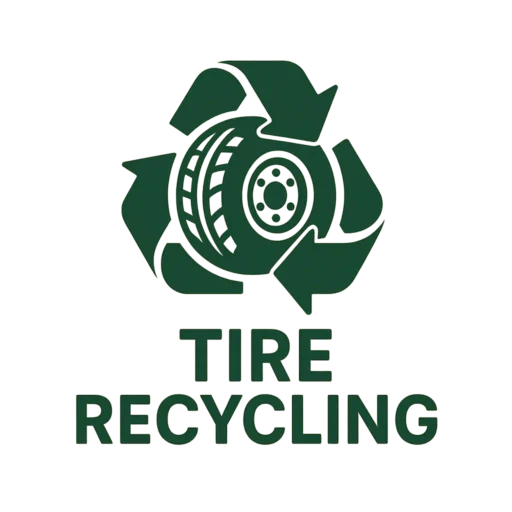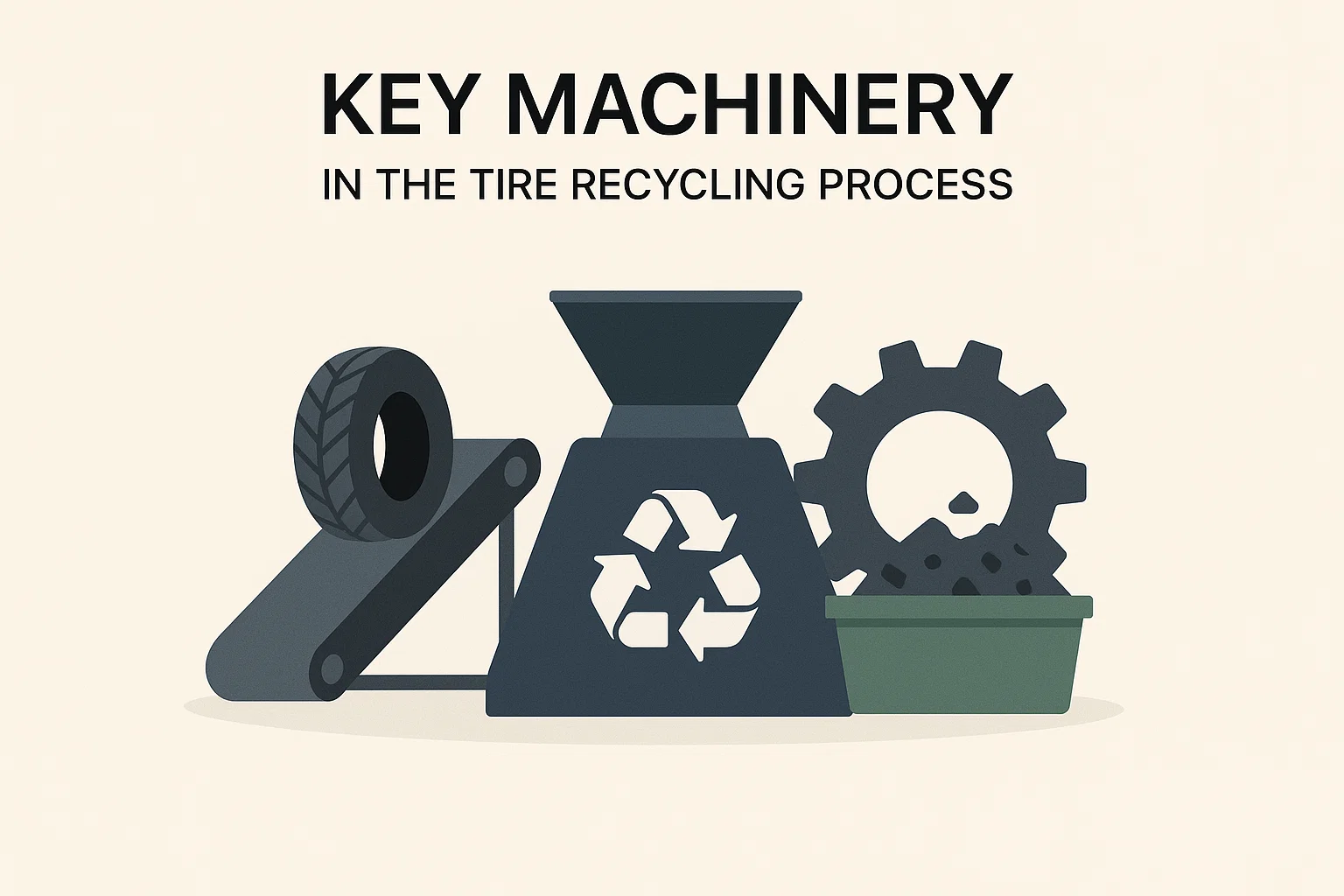The Growing Demand for Efficient Tire Recycling
Globally, an estimated one billion scrap tires are generated annually, creating a significant waste management challenge. This has spurred the growth of the tire recycling industry, which transforms this waste stream into valuable materials for construction, manufacturing, and energy. Effective tire recycling hinges on a sequence of sophisticated and durable machinery, each performing a critical function to break down tires and separate their core components: rubber, steel, and fiber.
For businesses entering or expanding within this sector, understanding the role of each piece of equipment is fundamental to designing an efficient and profitable operation. This article provides a comprehensive overview of the key machinery and equipment integral to the modern tire recycling process.
Stage 1: Pre-Treatment and Initial Size Reduction
Before the main recycling process begins, whole tires often undergo pre-treatment to prepare them for shredding. This initial stage is crucial for protecting downstream equipment and improving overall efficiency.
Tire Debeader / Wire Drawing Machine
The first step for many recycling lines is to remove the high-tensile steel bead wire embedded in the tire’s inner circumference. Tire debeaders, also known as wire drawing or extractor machines, use powerful hydraulic hooks or rollers to pull this thick steel ring out of the tire. Removing the bead wire at the start reduces wear and tear on the primary shredder’s blades and prevents potential damage.
Tire Cutters and Sidewall Removers
For very large tires, such as those from trucks or off-the-road (OTR) vehicles, a tire cutter may be used to slice them into smaller, more manageable segments before they enter the primary shredder. This step is often optional and depends on the size of the tires being processed and the intake capacity of the shredder.
Stage 2: Primary and Secondary Shredding
Shredding is the core of the tire recycling process, where whole tires or pre-cut pieces are broken down into smaller chips. This size reduction is essential for liberating the different materials within the tire.
Primary Tire Shredder
The primary shredder is a high-torque, low-speed machine designed to handle the initial breakdown of whole tires. These powerful machines use a series of interlocking knives to shear and rip tires into rough shreds, typically between 2 and 6 inches in size. The resulting material, often called tire-derived fuel (TDF) or rough-cut chips, can be sold as a commodity or sent for further processing. When selecting a primary shredder, key considerations include its processing capacity, durability, and maintenance requirements, as these directly impact daily production output.
Secondary Shredder / Rasper
After primary shredding, the tire chips move to a secondary shredder, often called a rasper or grater. This machine further reduces the rubber chip size to approximately 10-30 mm while playing a crucial role in liberating steel wire from the rubber. The rasper uses high-speed rotating blades to tear the rubber, effectively pulling the embedded steel wires free.
Stage 3: Material Separation and Purification
Once the tires are reduced to small chips and the components are liberated, the next critical phase is to separate the rubber, steel, and textile fibers into clean, reusable streams.
Magnetic Separators
Following the secondary shredding stage, the mixture of rubber and steel passes under powerful magnets. Magnetic separation systems, often in the form of overhead belt magnets or magnetic drums, efficiently lift the steel wire away from the rubber mulch. This process removes up to 99% of the steel, which can then be collected and sold as a valuable scrap commodity.
Fiber Separation System
Passenger and truck tires contain nylon or other textile fibers for reinforcement. To produce high-purity rubber granules, these fibers must be removed. A fiber separation system typically uses a combination of vibrating screens and high-velocity airflows to distinguish between the lighter textile fibers and the heavier rubber particles. The system effectively aspirates the fiber, leaving behind cleaner rubber granules ready for the final processing stages. Achieving a high purity level, often over 99%, is essential for enhancing the market value of the final rubber product.
Stage 4: Granulation and Fine Milling
The final stage of the mechanical recycling process involves reducing the clean rubber mulch into fine, uniform granules or powders, known as crumb rubber.
Granulator
The rubber mulch is fed into a granulator, which uses a series of spinning knives within a cutting chamber to dice the rubber into small, cubic crumbs, typically between 1 and 5 mm in size. The size of the output can be controlled by using different screen sizes. This step is critical for producing the uniform granules required for applications like playground surfaces, sports turf infill, and rubberized asphalt.
Fine Grinding Mill / Powderizer
For applications requiring even finer material, the rubber granules can be processed further in a fine grinding mill or powderizer. These machines grind the granules into a fine powder, often with a consistency similar to flour (20-100 mesh). This rubber powder is a key ingredient in the manufacturing of new rubber products, coatings, and sealants.
Alternative Process: Tire Pyrolysis
Beyond mechanical recycling, tire pyrolysis offers a thermochemical method to break down tires. This process involves heating shredded tires in an oxygen-free environment, which decomposes the rubber into valuable products without combustion.
Pyrolysis Plant Equipment
A typical tire pyrolysis plant consists of several key components:
- Pyrolysis Reactor: This is the core of the system where shredded tires are heated to high temperatures, causing them to break down into oil gas, carbon black, and steel wire.
- Oil Condensing System: The oil gas produced during pyrolysis is passed through a cooling system that condenses it into a liquid pyrolysis oil, which is similar to a number 2 grade fuel oil.
- Carbon Black and Steel Discharging Systems: The solid byproducts, carbon black and steel wire, are automatically discharged from the reactor for collection and further use.
Choosing the Right Machinery for Your Operation
Selecting the appropriate equipment is a critical decision that will define the efficiency, output quality, and profitability of a tire recycling facility. Key factors to consider include:
- Production Capacity: Determine your target processing volume to select machines that can meet your current and future needs.
- Tire Type: The machinery required may vary depending on whether you are processing passenger car tires, truck tires, or large industrial tires.
- Desired End Product: Your target market will dictate the final output size and purity. If you aim to produce fine rubber powder, a granulator and milling equipment are essential. If producing TDF is the goal, a primary shredder may suffice.
- Automation Level: Modern tire recycling lines can be semi-automatic or fully automatic. Fully automated systems reduce labor costs and improve consistency but require a higher initial investment.
Conclusion: Your Partner in High-Performance Recycling
The tire recycling process is a multi-stage operation that relies on a series of specialized, heavy-duty machines working in concert. From the initial power of the primary shredder to the precision of the granulator and the efficiency of separation systems, each piece of equipment plays an indispensable role in transforming waste into wealth.
At Rumtoo, we understand the complexities of the tire recycling industry. We provide robust, reliable, and technologically advanced machinery designed to meet the demands of international trade and industrial-scale operations. Our expertise ensures that you invest in a system that maximizes material recovery, maintains operational efficiency, and delivers high-quality end products.
Contact us today to request a quote and learn how Rumtoo’s plastic and rubber recycling solutions can drive your business forward.

